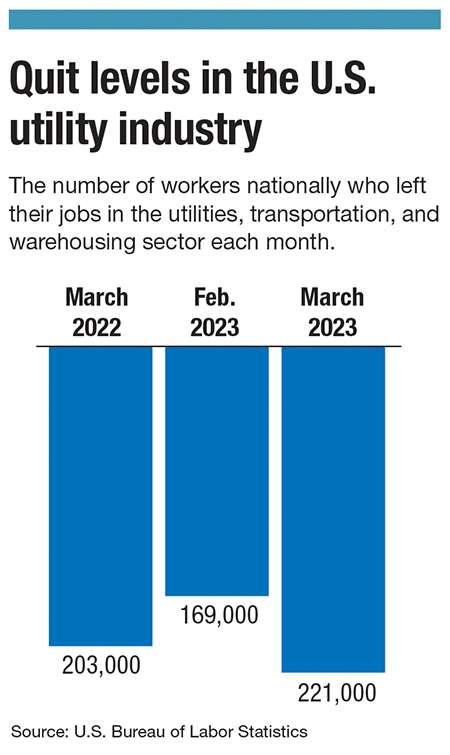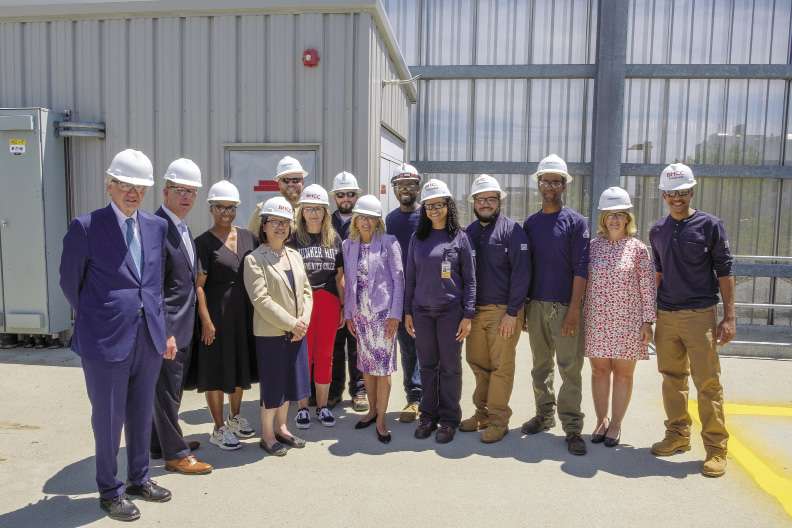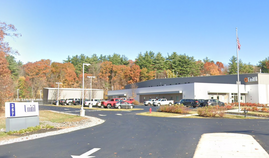
Electric utilities increase efforts to fill key jobs amid wave of generational retirements
 Photo | COURTESY of NATIONAL GRID
Trainees at the Energy Infrastructure Academy in Millbury receive instruction from National Grid supervisors on electrical safety and protocols.
Photo | COURTESY of NATIONAL GRID
Trainees at the Energy Infrastructure Academy in Millbury receive instruction from National Grid supervisors on electrical safety and protocols.
Sara Dalton worked in the service industry for years. She’d spent time in Maine, New Hampshire, and Massachusetts as a waitress, bartender, and in customer service. She’d moved around New England working. And now she needed to move home from New Hampshire back to Worcester to help take care of a sick family member. When that family member moved into a long-term care facility, she started to look for what was next. Dalton enrolled in classes at Quinsigamond Community College in Worcester and met with a counselor at the Massachusetts Rehabilitation Commission, which provided her with a computer and helped her pay for college as well as helped her figure out what she should study.
“I wasn’t going to go back to be a doctor,” Dalton said, “because by the time I finish all that schooling, I'd be the age of retirement.”
What she decided on was the energy sector: utilities.
“I like to learn and to challenge myself, but also I know that the energy sector as a whole, I'm not going to say is recession-proof because nothing is recession-proof, but utility companies aren’t going anywhere,” Dalton said.
What Dalton knew is at some point the exodus of the Baby Boomer generation from the workforce would hit the utility sector and its companies would soon need to replenish their workforces, especially when it comes to lineman and other frontline workers.
This exodus of experienced frontline utility workers was accelerated by the coronavirus pandemic and comes amid new government efforts to greatly expand the size of the New England electric grid, particularly to accommodate renewable electricity and clean energy efforts. The need for more utility workers is a main topic of industry focus right now, and it was one of the key discussion points during the Mass Energy Summit on May 12 at the DCU Center in Worcester.
The clean energy sector added 134,000 clean energy workers in 2021, and employment across the sector has grown by 73% since 2010, according to the 2022 Massachusetts Clean Energy Industry Report. To help the utilities find qualified employees, and to help people like Dalton looking to get into the industry, the Commonwealth of Massachusetts is bolstering funding for programs at the Massachusetts Clean Energy Center.
“We are investing more dollars into that Clean Energy Center to make it a hub for folks to get information and advance their programs,” State Rep. Jeffrey Roy (D-Franklin), chair of the Legislature’s Utilities & Energy Committee, said at the Mass Energy Summit, which was put on by Worcester Business Journal. “We put $50 million into the Clean Energy Center last year. We put another $25 million in this year's budget. We see them as a real great resource … One of the pilot programs that we put into the 2022 bill was an industry-recognized credentialing incentive program to get our traditional high schools and other educational institutions involved in training the workforce for tomorrow.”
Job openings, everywhere
In the wake of COVID, the Great Resignation was being touted as a cause for concern for employers looking for workers. In fact, though, older workers had begun leaving their job in a steady number since the Baby Boomer generation, which is the largest generation in American history, entered into retirement age starting in 2008.

“A record number of workers did quit their jobs in 2021, it’s true,” Joseph Fuller and William Kerr wrote in the Harvard Business Review in March 2022. “However, if you consider that number in the context of total employment during the past dozen years… You can see that what we are living through is not just short-term turbulence provoked by the pandemic but rather the continuation of a long-term trend.”
When the Baby Boomer generation reached age 62, which is the age at which workers can start to claim Social Security, in 2008, the generation began to call it quits on work, according to data from the Washington, D.C. nonprofit Pew Research Center. Between 2008 and 2019, the retired population ages 55 and older grew by nearly 1 million retirees per year. In the two years after 2019, the number of retirees 55 and older grew by 3.5 million.
What this means is that there will be openings. Industries have hard a hard time filling jobs, such as the national manufacturing industry, which lost roughly 1.4 million jobs at the onset of COVID and still has 693,000 open manufacturing jobs as of March 2023, according to the U.S. Chamber of Commerce.
The U.S. utilities, transportation and warehousing sector had major quit rates in the last year with more than 203,000 workers quitting in March 2022 and another 221,000 quitting in March of this year, according to the U.S. Bureau of Labor Statistics.

Utility training programs
Dalton was making a bet when she entered QCC what she studied could one day make her a perfect candidate for a job at the likes of National Grid or Eversource Energy. The utility companies in Massachusetts would need to keep hiring as the industry changed with new technology and power sources coming online like more solar and wind power, as well as electrification of motor vehicles.
National Grid has seen the trend lines and needed something to mitigate the loss of workers. In April, the utility company announced a new workforce development effort to provide people from historically underrepresented and marginalized communities career exposure, development, and employment opportunities. The new programs would help National Grid replenish its aging and retiring workforce by giving people clear pathways to work through four academies:
• Energy Infrastructure Academy, which is designed to prepare work-ready adults from underrepresented backgrounds for entry level to mid-level union roles with National Grid.
• Clean Energy Careers Academy, which gives college-age students mentors from National Grid to help them learn about the energy and utilities field.
• Clean Energy Tech Academy, which is for students in high school and vocational technical schools and gives them the opportunity to explore energy field careers.
• Clean Energy STEM Academy, which introduces middle-school-age students to the energy industry.
Not to be outdone, Eversource launched its own partnerships with Utility Workers Union of America and Bunker Hill Community College called the the Electric Power Utility Technology partnership, which was designed to build a diverse pipeline of technical talent for critical positions in electric operations, and incorporated a gas certificate in a partnership with USW Local 12004 later. The program has 18 spots for more than 200 applicants every year and gives those students classroom education and field training with Eversource crews. In 2022, First Lady Jill Biden visited Bunker Hill to see the program.

After finishing at QCC with a certificate in electrical utility technology in 2021, Dalton was asked if she would be interested in National Grid’s Energy Infrastructure Academy. She took on the chance and joined four other students in the program. At QCC, Dalton was supposed to have more hands-on experience with linesman work, but COVID caused disruptions, so this academy from National Grid proved a vital path for Dalton to get experience with the utility company.
Dalton is the perfect kind of candidate for National Grid. She’s someone the company is trying to reach with its new initiatives. Not only does she have the kind of education and certificates required, but she’s also someone who would have fallen through the cracks in the company’s previous recruitment phases.
“It's the first time ever in National Grid New England that we've had this kind of focus from a strategic workforce development standpoint,” said Amanda Downey, vice president of strategy development and partnerships at National Grid. “We have known, as you can imagine, it's not just National Grid, but nationally and certainly across Massachusetts: we just don't have enough people of color, enough women in the energy space. And National Grid has decided to do in a very thoughtful and intentional way to build a comprehensive, sustainable pipeline of diverse talent so that our workforce – not just today or tomorrow, but over the long haul – truly reflects the communities that we serve.”
The academies are finding talent that is oft-overlooked in the workforce or looked down on. It’s the people who completed high school but didn’t go to or finish college for various reasons.
“There's talent there,” Downey said. “In a nutshell, we're building that pipeline so that National Grid, over the long haul, will be able to ensure it has a diverse workforce to transition into that clean energy future.”












0 Comments